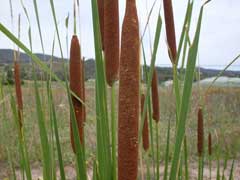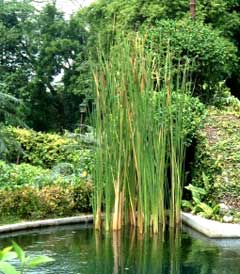 |
|
flickr.com/photos/31031835@N08/ |
 |
|
Translate this page:
Summary
Physical Characteristics

 Typha orientalis is a PERENNIAL growing to 3 m (9ft 10in) at a fast rate. It is in flower from May to August, and the seeds ripen from June to September. The species is monoecious (individual flowers are either male or female, but both sexes can be found on the same plant) and is pollinated by Wind.
Typha orientalis is a PERENNIAL growing to 3 m (9ft 10in) at a fast rate. It is in flower from May to August, and the seeds ripen from June to September. The species is monoecious (individual flowers are either male or female, but both sexes can be found on the same plant) and is pollinated by Wind.
Suitable for: light (sandy), medium (loamy) and heavy (clay) soils. Suitable pH: mildly acid, neutral and basic (mildly alkaline) soils. It cannot grow in the shade. It prefers wet soil and can grow in water.
UK Hardiness Map
US Hardiness Map
Synonyms
T. japonica.
Plant Habitats
Pond; Bog Garden;
Edible Uses
Edible Parts: Flowers Leaves Pollen Root Seed Shoots Stem
Edible Uses:
Roots - raw or cooked[105, 153]. They are usually peeled before use[173]. The roots can be boiled and eaten like potatoes or macerated and then boiled to yield a sweet syrup. They can also be dried, ground into a powder and then used as a thickener in soups etc or added to cereal flours. Rich in protein, this flour is used to make biscuits, bread, cakes etc. The root contains a lot of fibre[193]. One way to remove this fibre is to peel lengths of the root that are about 20 - 25cm long, place them by a fire for a short while to dry and then twist and loosen the fibres when the starch of the root can be shaken out[193]. Young shoots in spring - raw or cooked[105, 173, 178, 193]. An asparagus substitute. Base of mature stem - raw or cooked. It is best to remove the outer part of the stem. Young flowering stem - raw, cooked or made into a soup[105]. Tastes like sweet corn. Seed - cooked. The seed is rather small and fiddly to utilize, but has a pleasant nutty taste when roasted. An edible oil is obtained from the seed. Due to the small size of the seed this is probably not a very worthwhile crop[K]. Pollen - raw or cooked[153, 173]. A protein rich additive to flour used in making bread, porridge etc[183]. It can also be eaten with the young flowers, which makes it considerably easier to utilize. The pollen can be harvested by placing the flowering stem over a wide but shallow container and then gently tapping the stem and brushing the pollen off with a fine brush[9]. This will help to pollinate the plant and thereby ensure that both pollen and seeds can be harvested[K]. Flowering stem - cooked. Tastes like sweet corn.
References More on Edible Uses
Medicinal Uses
Plants For A Future can not take any responsibility for any adverse effects from the use of plants. Always seek advice from a professional before using a plant medicinally.
Anticoagulant Astringent Diuretic Emmenagogue Galactogogue Haemostatic Miscellany Tonic
The pollen is astringent, diuretic, emmenagogue, galactogogue, haemostatic and [176, 178]. The dried pollen is said to be anticoagulant, but when roasted with charcoal it becomes haemostatic[238]. It is used internally in the treatment of kidney stones, haemorrhage, painful menstruation, abnormal uterine bleeding, post-partum pains, abscesses and cancer of the lymphatic system[222, 238]. It should not be prescribed for pregnant women[238]. Externally, it is used in the treatment of tapeworms, diarrhoea and injuries[238].
References More on Medicinal Uses
The Bookshop: Edible Plant Books
Our Latest books on Perennial Plants For Food Forests and Permaculture Gardens in paperback or digital formats.

Edible Tropical Plants
Food Forest Plants for Hotter Conditions: 250+ Plants For Tropical Food Forests & Permaculture Gardens.
More

Edible Temperate Plants
Plants for Your Food Forest: 500 Plants for Temperate Food Forests & Permaculture Gardens.
More

More Books
PFAF have eight books available in paperback and digital formats. Browse the shop for more information.
Shop Now
Other Uses
Biomass Fibre Insulation Miscellany Paper Soil stabilization Stuffing Thatching Weaving
The stems have many uses, gathered in the autumn they make a good thatch, can be used in making paper, can be woven into mats, chairs, hats etc[153, 173, 178]. They are a good source of biomass, making an excellent addition to the compost heap or used as a source of fuel etc. A fibre obtained from the leaves can be used for making paper[189] The leaves are harvested in summer, autumn or winter and are soaked in water for 24 hours prior to cooking. The fibres are cooked for 2 hours with soda ash and then beaten in a ball mill for 1½ hours. They make a green or brown paper[189]. A fibre is obtained from the blossom stem and flowers. A fibre obtained from the roots can be used for making string[193]. The hairs of the fruits are used for stuffing pillows etc[173]. They have good insulating and buoyancy properties and have also been used as a wound dressing and a lining for babies nappies.. The stems can be used to make rush lights. The outer skin is removed except for a small strip, or spine, running the entire length to give stability. The stem is then soaked in oil. The pollen is highly inflammable, it is used in making fireworks etc.
Special Uses
References More on Other Uses
Cultivation details
Grow in a rich soil in boggy pond margins or shallow water to 15cm deep[1, 200]. Succeeds in sun or part shade[200]. Plants can be very invasive, spreading freely at the roots when in a suitable site[200]. Provides excellent cover for wildlife.
References Carbon Farming Information and Carbon Sequestration Information
Temperature Converter
Type a value in the Celsius field to convert the value to Fahrenheit:
Fahrenheit:
The PFAF Bookshop
Plants For A Future have a number of books available in paperback and digital form. Book titles include Edible Plants, Edible Perennials, Edible Trees,Edible Shrubs, Woodland Gardening, and Temperate Food Forest Plants. Our new book is Food Forest Plants For Hotter Conditions (Tropical and Sub-Tropical).
Shop Now
Plant Propagation
Seed - surface sow in a pot and stand it in 3cm of water. Pot up the young seedlings as soon as possible and, as the plants develop, increase the depth of water. Plant out in summer. Division in spring. Very easy, harvest the young shoots when they are about 10 - 30cm tall, making sure there is at least some root attached, and plant them out into their permanent positions.
Other Names
If available other names are mentioned here
Native Range
TEMPERATE ASIA: Russian Federation (Primorye), China (Anhui Sheng, Zhejiang Sheng, Heilongjiang Sheng, Henan Sheng, Hebei Sheng, Jiangxi Sheng, Jiangsu Sheng, Jilin Sheng, Guangdong Sheng, Liaoning Sheng, Shanxi Sheng, Shaanxi Sheng, Yunnan Sheng, Nei Mongol Zizhiqu), Japan (Honshu, Kyushu, Shikoku), Taiwan TROPICAL ASIA: Papua New Guinea, Philippines AUSTRALASIA: Australia (Tasmania, New South Wales, Queensland, South Australia, Victoria, Northern Territory (north)), New Zealand (Kermadec Islands, North Island, South Island)
Weed Potential
Right plant wrong place. We are currently updating this section.
Please note that a plant may be invasive in one area but may not in your area so it's worth checking.
Conservation Status
IUCN Red List of Threatened Plants Status :

Growth: S = slow M = medium F = fast. Soil: L = light (sandy) M = medium H = heavy (clay). pH: A = acid N = neutral B = basic (alkaline). Shade: F = full shade S = semi-shade N = no shade. Moisture: D = dry M = Moist We = wet Wa = water.
Now available:
Food Forest Plants for Mediterranean Conditions
350+ Perennial Plants For Mediterranean and Drier Food Forests and Permaculture Gardens.
[Paperback and eBook]
This is the third in Plants For A Future's series of plant guides for food forests tailored to
specific climate zones. Following volumes on temperate and tropical ecosystems, this book focuses
on species suited to Mediterranean conditions—regions with hot, dry summers and cool, wet winters,
often facing the added challenge of climate change.
Read More
Expert comment
Author
C.Presl.
Botanical References
158266
Links / References
For a list of references used on this page please go here
Readers comment
© 2010, Plants For A Future. Plants For A Future is a charitable company limited by guarantee, registered in England and Wales. Charity No. 1057719, Company No. 3204567.